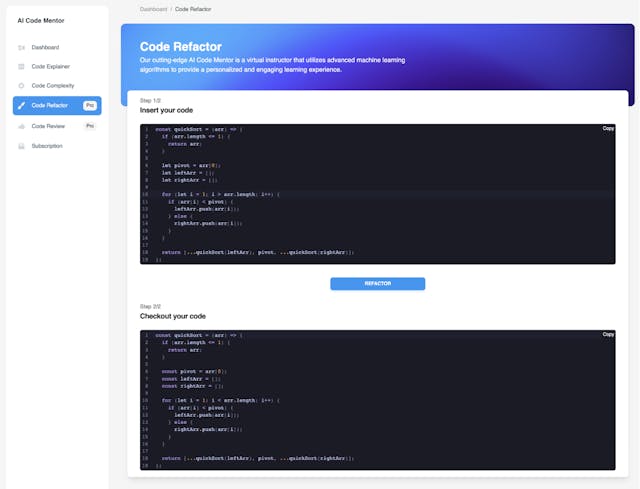
Start coding smarter today with the ultimate explainer tool
based on Artificial Intelligence for optimizing, refactoring, and reviewing code!
Step 1
Insert the code you want to be
explained.
Step 2
Choose how you want the
code to be explained.
Insert your code
How do you want the code to be explained to you?
Robot
5 Years Old
Beginner Programmer
Teacher
NASA Programmer
Pizza Delivery Guy
Bus Driver
Magician
Barista
Doctor
Here you can find more examples
This code defines a function called bblSort which takes an array as input and sorts it in ascending order using the Bubble Sort algorithm.
The function begins by initializing a variable i to 0, and then enters a for loop that runs while i is less than the length of the input array arr. In each iteration of the outer loop, another for loop is entered, with a variable j initialized to 0.
The inner loop runs while j is less than the difference between the length of the array arr and the current value of i, minus 1. This means that in each iteration of the outer loop, the inner loop will compare one less element at the end of the array, because the largest element has already been sorted in the previous iteration.
Within the inner loop, the algorithm compares the jth element of the array with the j+1th element of the array. If the jth element is greater than the j+1th element, it swaps their positions in the array using a temporary variable temp. This process continues until the end of the inner loop is reached.
Once both loops have completed, the sorted array is output to the console using the console.log method.
In summary, this code implements the Bubble Sort algorithm to sort an input array in ascending order.
This code defines a function called quickSort which takes an array as input and sorts it in ascending order using the Quick Sort algorithm.
The function first checks whether the input array has a length of 1 or less. If so, it simply returns the input array as it is already sorted.
If the input array has a length greater than 1, the function selects the first element in the array as the pivot. It then initializes two empty arrays, leftArr and rightArr.
Next, the function enters a for loop that iterates over the remaining elements in the input array (i.e. starting from index 1). For each element, it compares it with the pivot. If the element is less than the pivot, it is added to the leftArr. Otherwise, it is added to the rightArr.
Once the for loop has completed, the function recursively calls itself on the leftArr and rightArr, and concatenates the result with the pivot element. This process continues until the entire array has been sorted.
In summary, this code implements the Quick Sort algorithm to sort an input array in ascending order by recursively dividing the input array into subarrays based on a pivot element, and then merging the subarrays back together in sorted order.
This code implements the Heap Sort algorithm to sort an array of integers in ascending order.
The sort function takes an input array arr and first calculates the length of the array N. It then enters a for loop that initializes a heap by calling the heapify function on each non-leaf node in the heap. The loop iterates over all non-leaf nodes in the heap, starting from the bottom-most layer and working its way up.
After the heap has been initialized, the sort function enters another for loop that sorts the input array. In each iteration of the loop, the function swaps the first (maximum) element in the heap with the last element in the heap, decrements the size of the heap by 1, and then re-heapifies the remaining elements in the heap.
The heapify function takes three arguments: the input array arr, the size of the heap N, and the index of the current node in the heap i. The function first initializes a variable largest to the current node index i, and calculates the indices of the left child l and right child r of the current node.
The function then checks whether the left or right child is larger than the current node. If so, it updates the value of largest accordingly.
Finally, if the value of largest has changed from i, the function swaps the values of arr[i] and arr[largest], and then recursively calls itself on the affected child node.
The printArray function simply prints the elements of an input array to the document.
In the main part of the code, an example input array arr is defined and passed to the sort function. The sorted array is then printed to the document using the printArray function.
This is an implementation of the radix sort algorithm in JavaScript.
Radix sort is a non-comparative integer sorting algorithm that sorts data with integer keys by grouping the keys by individual digits that share the same significant position and value. It is a linear time complexity algorithm, which makes it efficient for sorting large sets of data.
The code begins by defining a function named radixSort that takes an array of integers (arr) as input. It finds the maximum number of digits in the input array by calling the largestNum function, which returns the number with the most digits.
Then, a loop is started to go through each digit of the numbers in the input array, starting from the least significant digit (i.e., the ones place) and moving towards the most significant digit (i.e., the highest place value). For each digit, a set of buckets (an array of 10 empty arrays) is created to hold the integers with the same digit in that place.
Another loop is started to go through each integer in the input array. For each integer, its digit in the current place value is extracted using the getNum function and used as an index to add the integer to the appropriate bucket.
After all the integers have been placed in their respective buckets, the contents of the buckets are concatenated and stored in the original arr array. This process repeats for each digit until the entire array is sorted.
Finally, the sorted arr is returned by the function.
Overall, this implementation of radix sort works by sorting the input array digit by digit, starting from the least significant digit and moving towards the most significant digit. By sorting each digit separately, the algorithm avoids the need to compare and swap individual elements, resulting in a more efficient sorting process.
AI Code Mentor is an code explainer based on Artificial Intelligence (AI) designed to help developers of all levels, but especially beginners, understand how code works across a variety of programming languages.
This tool is intuitive, you just need to enter the code you are interested in and choose how you want it to be explained. Using AI Code Mentor, you will gain a deeper understanding of the programming logic, becoming a better developer.

Speed up your code development
Code Complexity
Forget about the dozen lines of complicated code that are difficult to maintain, harder to update, and slower in performance! Say hello to a simpler, cleaner code that anyone could read and understand.
AI Code Mentor is here to help you optimize your code so you can focus on the functionalities.

Code Review
The code review process is one of the most crucial steps in building a web project, and the truth is that it can be time-consuming and less efficient at times.
Our AI-based tool will guide you through this process by reviewing your code instead of you and providing all the necessary explanations.

AI Code Mentor
See our pricing
Choose your favorite plan.
Basic Plan
Free
Code Explainer
Code Complexity
500 Characters
Code Refactor
Code Review
5 New Explainer Models
Pro Monthly Plan
$7/mth
Code Explainer
Code Complexity
2000 Characters
Code Refactor
Code Review
5 New Explainer Models
Pro Yearly Plan
$29/year
Code Explainer
Code Complexity
2000 Characters
Code Refactor
Code Review
5 New Explainer Models
Everything you need to know about AI Code Mentor
Join our newsletter
By subscribing, you'll be the first to know about the latest news and updates.
